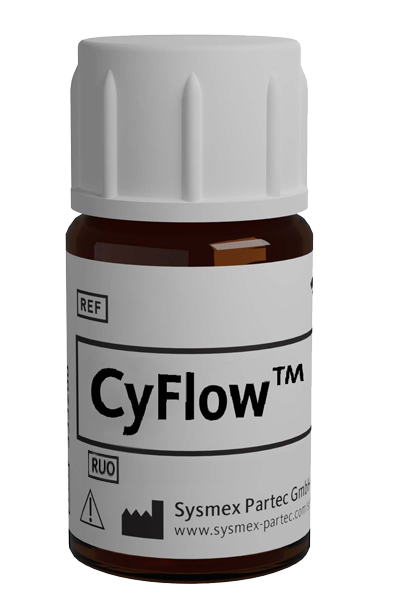CyFlow™ STRO1 PE

| Antibody: | Yes |
| Antigen: | STRO1 |
| Application: | Flow cytometry |
| Clonality: | monoclonal |
| Clone: | STRO-1 |
| Emission Maximum: | 576 nm |
| Excitation Maximum: | 496 nm, 565 nm |
| Field of Interest: | Immunophenotyping |
| Format/Fluorochrome: | PE |
| Isotype: | IgM |
| Laser: | Blue , Green, Yellow |
| Regulatory Status: | RUO |
| Source Species: | Mouse |
| Target Species: | Human |
| Product number: | BA518386 |
For Research Use Only
| Concentration Unit | mg/mL |
| Concentration | 0,1 |
| Quantity | 0.1 mg |
| Volume | 1.0 mL |
| Immunogen | Human CD34 positive bone marrow cells |
| Background Information | STRO-1 is a cell surface antigen expressed by stromal elements in human bone marrow, identified by monoclonal antibody STRO1. Approximately 10% of mononuclear cells, greater than 95% of which are nucleated erythroid precursors, are STRO-1 positive, whereas the CFU-GM (colony-forming unit granulocyte-macrophage), BFU-E (erythroid burst) and CFU-Mix (mixed colonies) committed progenitor cells are negative. CFU-F (fibroblast colony-forming cells) are present exclusively in the STRO-1 positive population. When plated under long-term bone marrow culture conditions, STRO-1 positive cells generate adherent cell layers containing multiple stromal cell types, including adipocytes, smooth muscle cells, osteoblasts, chondrocytes, and fibroblastic elements. In combination with glycophorin A, STRO-1 is a useful marker for identification of mesenchymal stem cells. STRO-1 and CD117 are markers for osteosarcoma cells. |
| Usage | The reagent is designed for Flow Cytometry analysis. Working concentrations should be determined by the investigator. |
| Storage Buffer | The reagent is provided in stabilizing Tris buffered saline (TBS) solution, pH ≈8.0, containing 0.09% (w/v) sodium azide. |
| Storage | Avoid prolonged exposure to light. Store in the dark at 2-8°C. Do not freeze. |
| Stability | Do not use after expiration date stamped on vial label. |
| Simmons PJ, Torok-Storb B: Identification of stromal cell precursors in human bone marrow by a novel monoclonal antibody, STRO‑1. Blood. 1991 Jul 1; 78(1):55‑62. < PMID: 2070060 > | Oyajobi BO, Lomri A, Hott M, Marie PJ: Isolation and characterization of human clonogenic osteoblast progenitors immunoselected from fetal bone marrow stroma using STRO‑1 monoclonal antibody. J Bone Miner Res. 1999 Mar; 14(3):351‑61. < PMID: 10027900 > | Stenderup K, Justesen J, Eriksen EF, Rattan SI, Kassem M: Number and proliferative capacity of osteogenic stem cells are maintained during aging and in patients with osteoporosis. J Bone Miner Res. 2001 Jun; 16(6):1120‑9. < PMID: 11393789 > | Gronthos S, Zannettino AC, Hay SJ, Shi S, Graves SE, Kortesidis A, Simmons PJ: Molecular and cellular characterisation of highly purified stromal stem cells derived from human bone marrow. J Cell Sci. 2003 May 1; 116(9):1827‑35. < PMID: 12665563 > | Bensidhoum M, Chapel A, Francois S, Demarquay C, Mazurier C, Fouillard L, Bouchet S, Bertho JM, Gourmelon P, Aigueperse J, Charbord P, Gorin NC, Thierry D, Lopez M: Homing of in vitro expanded Stro‑1‑ or Stro‑1+ human mesenchymal stem cells into the NOD/SCID mouse and their role in supporting human CD34 cell engraftment. Blood. 2004 May 1; 103(9):3313‑9. < PMID: 14715641 > | Seo BM, Miura M, Sonoyama W, Coppe C, Stanyon R, Shi S: Recovery of stem cells from cryopreserved periodontal ligament. J Dent Res. 2005 Oct; 84(10):907‑12. < PMID: 16183789 > | Kaneko R, Akita H, Shimauchi H, Sasano Y: Immunohistochemical localization of the STRO‑1 antigen in developing rat teeth by light microscopy and electron microscopy. J Electron Microsc (Tokyo). 2009 Dec; 58(6):363‑73. < PMID: 19525367 >
